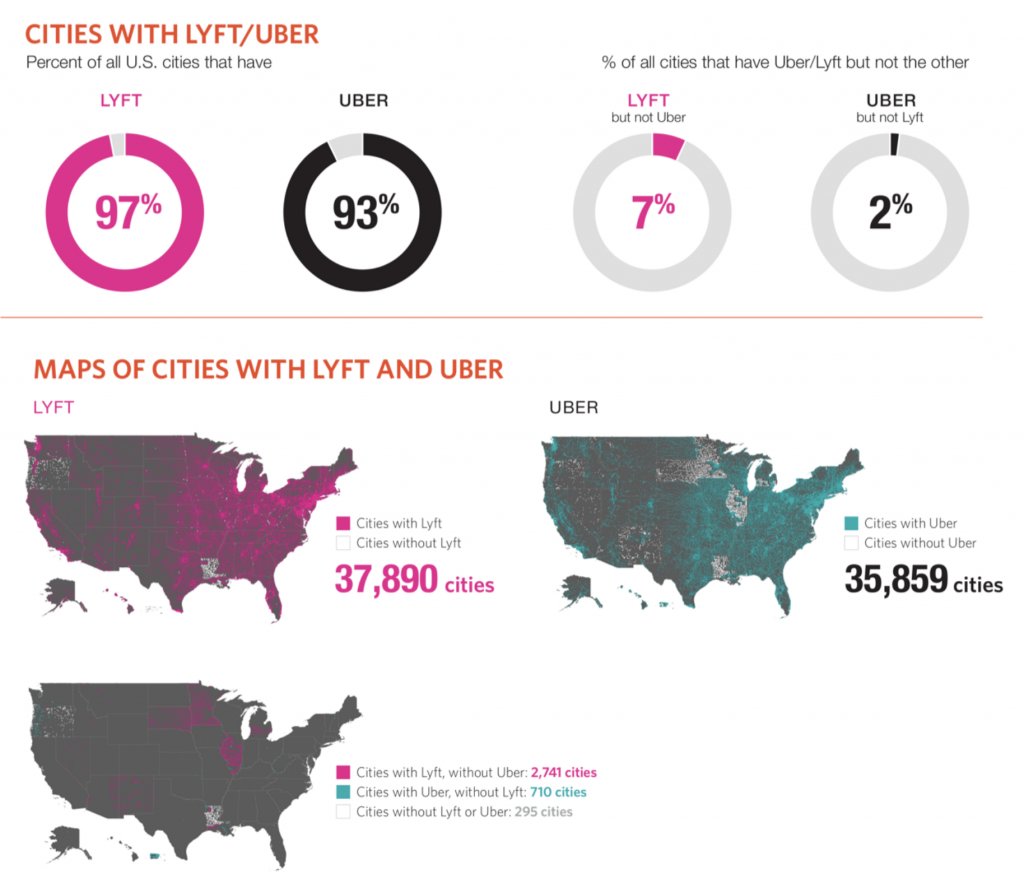FAQ - Coverage Areas
How many cities in the US have Uber Pool or Lyft Shared?
How many cities in the US have Uber and Lyft?
As of the end of 2019, 37,890 cities in the US had at least one Lyft service, which is approximately 97% of all cities in the US.
As of the end of 2019, 35,859 cities in the US had at least one Uber service, which is approximately 93% of all cities in the US.
Lyft had about 4% greater coverage in the US than Uber, in terms of number of cities with the service. 2,741 cities had Lyft service, but not Uber service. 710 cities had Uber service, but not Lyft service. 295 cities did not have either Uber or Lyft coverage.

Which countries does Lyft operate in?
Lyft operates in all 50 states in the United States Canada. The company expanded into Canada when it began operations in Toronto in December 2017.
Where is Uber or Lyft banned?
While Lyft and Uber are allowed in the 100 largest cities in the United States, there are other places that don’t allow the companies to carry passengers. Oregon is the only state that explicitly prohibits Lyft and Uber operations in the vast majority of its counties. Riders in Portland can use these services but the companies cannot operate elsewhere in the state as of April 2019. Most states have implemented licensing and insurance requirements in response to safety concerns from critics.
Uber and Lyft have faced more regulatory challenge during their expansion into the global market. Major cities like London and Vancouver prohibit ride-hailing apps from carrying rides. National bans in Bulgaria, Denmark, France, Hungary, and Italy emerged after protests by taxi companies. These limitations emerged because Lyft and Uber represent competitive challenges to traditional taxi services.
Can Uber or Lyft drivers work in other states?
How far does Uber or Lyft go?
Uber
Uber does not set a maximum distance for each ride. The company does inform riders and driver-partners that each ride may be ended after four hours. Driver-partners are informed prior to the four-hour mark to bypass ride termination as necessary. Uber also limits each driver-partner to 12 hours of consecutive operation that could limit long-distance trips.
Lyft
Lyft limits each ride to a total distance of 100 miles. As the ride approaches 100 miles, the driver is warned that the ride will end. The ride’s termination means that the rider would need to request another Lyft ride to continue the trip, which could be carried out by the current driver or another available driver. Lyft drivers are also limited to 14 consecutive hours in the app before a mandatory six-hour break is enforced.
Can Uber or Lyft pick up at airports?
Regulations on airport pickups and drop-offs by ride-hailing companies like Uber and Lyft vary from state to state. The companies list more than 100 airports in the United States where they are allowed to operate. These airports include major international airports in New York City, Los Angeles, Washington, D.C., and Chicago. Lyft lists eight airports in the Canadian province of Ontario that allow ride-hailing services, while Uber is available in global cities like Cairo, Paris, Sydney, and Tokyo.
Travelers using Lyft and Uber at airports may be asked to walk to specific areas to meet their drivers. This policy keeps airport traffic from bogging down at peak periods. Both apps are designed to direct users to pick-up locations at each airport. You may receive turn-by-turn directions or simple instructions on where to go to find your driver. At smaller airports, your Lyft or Uber driver may be able to meet you closer to the departures area.
Drivers who include airports as part of their Uber or Lyft experiences may be required to purchase airport permits before completing rides. Taxi companies and local regulators have advocated for permits to bring ride-hailing services to the same level of scrutiny as traditional transportation providers. Both companies encourage drivers to be honest with riders if they are not permitted to take passengers to the airport. The alternatives for Uber and Lyft riders is to be dropped off at airport shuttle or public transit stops that serve airports.